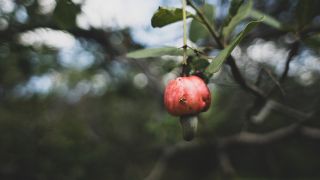Education
Yucky! How Do Toddlers Learn About Disgust?
Disgust is a powerful emotion, but hard to learn for children.
Posted February 16, 2023 Reviewed by Michelle Quirk
Key points
- Disgust is an important emotion designed to keep us safe.
- Children find it harder to learn about disgust compared to other emotions.
- Introduce disgust-related words within the right context to toddlers.

I must have been around 6 years old. We lived in Kasaragod, a coastal city in Kerala, India, at the time. I was playing Tennikoit with one of my classmates outside my house.
At one point, I missed catching the ring and chased it as it rolled behind a tree. I picked the ring up to find a sticky, gloopy mess on my palm. The ring had rolled over a rotten cashew fruit and, unfortunately for young me, my hand smelled vile. All these years later, the memory and that smell of overripe fruit still seem fresh.
Disgust is a powerful emotion. Yet, it is an ignored emotion that likely wouldn’t feature on our list of top-five feelings. When shown pictures of facial expressions, young children often have the hardest time labeling disgust (and fear) as compared to happiness, sadness, and anger.
A Hard Emotion for Children to Learn?
In a classic study conducted with 2- and 3-year-olds, researchers found that children’s use of the basic language of disgust relating to physical events (e.g., saying “yucky”) emerges in the second or third year of life. When these children were asked why someone might feel disgusted, one of them reportedly said, “He has garbage in his mouth!”
Toddlers’ understanding of disgust begins with physical events—they experience distaste, aversion, and rejection of things that taste bad. Essentially, this is the foundation for children coming to terms with disgust as an emotion.
Young children do not fully understand disgust as a concept until they are at least 4 years old. It is around this age that they begin to recognize facial expressions for disgust. Many children may not have a full command of the meaning of disgust until early elementary school.
While it is a powerful emotion, disgust is hard to learn—most experiences are new to children at this age, and children also encounter fewer everyday experiences that are disgusting. This may also explain why it takes longer for children to acquire the vocabulary to express and explain disgust.
Play to Support Toddlers' Learning About Disgust
Researchers at the University of California, San Diego, conducted a study in 2012 with 18-month-old toddlers. They presented toddlers with unfamiliar-looking toys—one of these toys was a remote-controlled spider that moved in random directions.
In the presence of these toys, they had the toddlers’ parents either say, “That’s a nice toy” or “That’s a nasty toy.” They found that nearly every toddler in the control group avoided the toy when their parent called it nasty.
Environmental situations like these are crucial. They help toddlers learn from their parents' reactions—for example, that worms are disgusting. The disgust-related vocabulary terms used by the parent such as “yucky,” “nasty,” or “eww” help toddlers label the emotion.

Given how rarely these situations may occur in real life, some games might help toddlers gain fluency in identifying and labeling things that are “yucky.” I used to work with preschoolers with language delays, and we often played a board game in the classroom that contained pieces of good-looking food and nasty food items overrun with maggots and other insects. The game involved lining up our plates with food, and the first one to have a full plate was the winner.
The kids and I took turns picking up cards, and if the food was safe to be eaten, we could line it up on our plates. If the food looked disgusting and unsafe to eat, the class yelled, “Yucky, tummy ache” and placed the piece in a “trash” pile. It remains one of my favorite board games and a fun way to build fluency with disgust words.
Beyond Physical Disgust
As you may have observed, physical disgust is expected to protect children (and adults) from touching or eating items that could be harmful. It is an important safety mechanism. But is that the whole picture, and does disgust only relate to physical events?
Some researchers have argued that moral disgust protects us from doing things that are perceived as morally wrong. A recent study showed that some 7- to 9-year-olds identify cheating, jumping the queue, and playing with someone who steals a snack as disgusting.
While there is still debate as to whether these events truly elicit disgust or anger, overall emotional development is strongly correlated to well-being.
No Stereotypes Please

Some disgust attributes are socially learned—while you and I may find it disgusting to eat the chocolates shaped like poop that were trending in the United Kingdom recently, toddlers might find it unremarkable or even amusing! This is exactly why we need more learning opportunities, and more realistic ones.
Stereotypical facial expressions in books and simply teaching preschoolers to imitate these will not translate to better communication or socio-emotional development. While useful, teaching children to recognize smiles, frowns, and scowls does not even begin to cover their emotional learning.
The early ability of children to associate specific emotion terms with a range of facial expressions and events lays the foundation for all emotional development. So, let’s label our disgust (and other emotions) at situations and empower young children with opportunities to build stories and contexts around these internal states.
References
Aznar, A., Tenenbaum, H. R., & Russell, P. S. (2023). Is moral disgust socially learned?. Emotion (Washington, D.C.), 23(1), 289–301. https://doi.org/10.1037/emo0001066
Bretherton, I., & Beeghly, M. (1982). Talking about internal states: The acquisition of an explicit theory of mind. Developmental Psychology, 18(6), 906–921. https://doi.org/10.1037/0012-1649.18.6.906
Cornew, L., Dobkins, K. R., Akshoomoff, N., McCleery, J. P., & Carver, L. J. (2012). Atypical social referencing in infant siblings of children with autism spectrum disorders. Journal of autism and developmental disorders, 42(12), 2611–2621. https://doi.org/10.1007/s10803-012-1518-8




